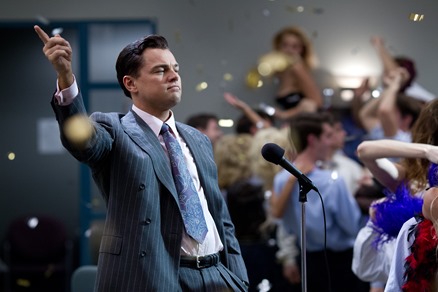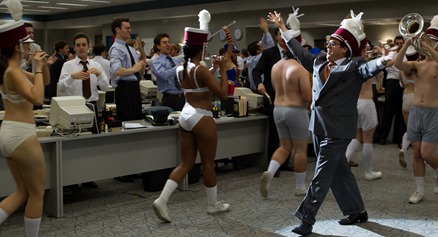Martin Scorsese’s The Wolf of Wall Street is a gloriously debauched rigs-to-riches-to-jail tale that soars for its first two-and-a-half hours – then changes tone and runs out of steam. It deserves its hard R-rating.
Based on the book by Jordan Belfort, The Wolf of Wall Street follows the journey of a naive wannabe stockbroker named Jordan Belfort (Leonardo DiCaprio) from his less than glamorous start as a newbie who is amazed when an older, wiser-to-the-world-of-Wall Street broker (Matthew McConaughey) takes him to lunch and explains how things really work – broken down into two simple rules. Belfort clearly doesn’t believe him then, but by the time he’s become successful – just before the recession – everything he does follows them, with an over-the-top greed that finds him scamming people on penny stocks; gathering his cohorts from a divey boiler room operation to a new, quasi-respectable firm he creates out of thin air called Stratton Oakmont.
Along the way, he picks up an inhibition-free sidekick named Donnie Azoff (Jonah Hill) and inner circle with nicknames like Rugrat (P.J. Byrne), Sea Otter (Henry Zebrowski) and Pinhead (Brian Sacca) and they all achieve a level of success that enables them to party like Caligula. The scenes of drug-taking, orgies and general debauchery are such that you have to wonder a) how Scorsese got this film an R-rating, and b) what cuts did he make.
As you expect from Scorsese, The Wolf of Wall Street is beautifully made – gorgeous cinematography, brilliant performances, superb use of music. The journey from naïf to reptilian predator is as involved (and involving) as anything he’s done. What’s unexpected, though, is that Wolf is kind of a comedy take on the corruption caused by power that is a flipside to, say, Goodfellas or Casino. The Wolf of Wall Street takes its lusts (for money, power, drugs, sex) every bit as far – though its violence isn’t of a physical nature, the damage done by Belfort and his associates is every bit as terrifying (maybe even more so because of the film’s comic tone).
DiCaprio and Hill seem like shoo-ins for Oscar® nominations, but Byrne is superb as Rugrat (so called because of his incredibly awful hairpiece) and Margot Robbie is unforgettable as Naomie Lapaglia the woman who steals Belfort away from his first wife.
In the end, Belfort is undone by a smarter, incorruptible FBI agent, Patrick Denham (Kyle Chandler) – the kind of guy who takes the subway to work, wear the same (cheap) suit three days in row and is probably faithful to his wife. There’s a meeting between Denham and Belfort that is one of the best cat-and-mouse give-and-take scenes of the last decade. Both men think they’re in control and only one of them is right.
While Scorsese takes Belfort’s excesses and spins them into a mostly comedic film (albeit with incredibly dark undercurrents), when things begin to turn sour, the film shifts into a more dramatic mode (without forsaking its comedic sensibilities entirely) and The Wolf of Wall Street begins to lose steam. By then, we’re 150 minutes in and the characters, as repellent as they are, have been so fascinating in their predatory glee that the film glides to a halt rather than crashing completely.
DiCaprio’s glib – and thorough (Belfort seems to need to explain how things work – to persuade the audience that he is really a brilliant guy) – narration is frequently as hilarious as anything going on onscreen. Even as just a voiceover, Belfort is smug and self-satisfied. Part of his genius, though, is as a motivational speaker – when he cuts a deal with the SEC, his farewell speech to his Stratton Oakmont cronies is so good he talks himself out of leaving.
If The Wolf of Wall Street had been even twenty minutes shorter, it could have been the best film of the year. As it is, it’s still one of them.
Final Grade: A-
Photos by Mary Cybulski/Courtesy of Paramount Pictures

